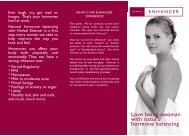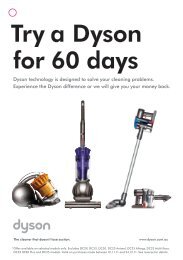Warning - TVSN
Warning - TVSN
Warning - TVSN
Create successful ePaper yourself
Turn your PDF publications into a flip-book with our unique Google optimized e-Paper software.
Intense Pulsed Light<br />
Permanent Hair Reduction<br />
Instruction Manual<br />
Permanent Hair Reduction 1
Skin tone chart<br />
Use this skin tone chart to select the<br />
iPulse setting that most closely matches<br />
the area you want to treat.<br />
If you are unsure about your skin tone,<br />
always use a setting for darker skin<br />
which delivers a more gentle treatment.<br />
iPulse is not effective on;<br />
• Red hair<br />
• Grey or white hair<br />
• Very blonde hair<br />
<strong>Warning</strong><br />
Do not use;<br />
• if the skin to be treated is darker than<br />
the dark (III) skin tone shown on the<br />
skin tone chart.<br />
• If you have a parent or grandparent<br />
who is naturally dark skinned (in the<br />
DO NOT USE category on the skin<br />
tone chart) even if your skin tone is<br />
fair (I), medium (II) or dark (III) on the<br />
chart. Darker skin tones absorb too<br />
much light during treatment which<br />
may cause serious skin injury.<br />
• on areas that have been fake or<br />
naturally tanned in the last four weeks.<br />
See Appendix B for further help and<br />
advice about identifying your skin tone.<br />
2
Contents<br />
Skin tone chart ................................................................................................................. 2<br />
How to use summary ....................................................................................................... 4<br />
Recommended additional products .................................................................................... 4<br />
Welcome to iPulse ............................................................................................................ 4<br />
What iPulse can do for you? ............................................................................................... 4<br />
How does iPulse work? ...................................................................................................... 4<br />
What to expect when using iPulse? .................................................................................... 5<br />
1. Before you start ............................................................................................................ 6<br />
2. <strong>Warning</strong>s and Safety information ................................................................................ 6<br />
Skin type ............................................................................................................................ 6<br />
Tanned or fake tanned skin ................................................................................................. 6<br />
Areas not to treat ................................................................................................................ 6<br />
When not to use ................................................................................................................. 7<br />
Medical warnings ................................................................................................................ 7<br />
Electrical warnings .............................................................................................................. 8<br />
3. Patch testing ................................................................................................................. 9<br />
4. Getting ready for a treatment ..................................................................................... 10<br />
Gathering together the essentials you may need ............................................................... 10<br />
Set up iPulse .................................................................................................................... 10<br />
5. Beginning your iPulse Treatment ............................................................................... 11<br />
Under arms ...................................................................................................................... 14<br />
Legs ................................................................................................................................. 14<br />
Bikini Line ......................................................................................................................... 14<br />
Face and neck .................................................................................................................. 15<br />
Advice for women ............................................................................................................. 16<br />
Advice for men ................................................................................................................. 16<br />
Breast ............................................................................................................................... 17<br />
Back ................................................................................................................................. 17<br />
Arms ................................................................................................................................ 17<br />
6. Aftercare ..................................................................................................................... 18<br />
7. Cleaning iPulse ........................................................................................................... 18<br />
8. Possible adverse reactions ....................................................................................... 19<br />
9. Troubleshooting .......................................................................................................... 20<br />
10. Technical specification ............................................................................................. 21<br />
11. Treatment record card .............................................................................................. 22<br />
Summary diagram .......................................................................................................... 23<br />
Appendix A—Incompatible medications ....................................................................... 24<br />
Appendix B—Skin Tone questionnaire .......................................................................... 25<br />
Index ............................................................................................................................... 27<br />
Permanent Hair Reduction 3
How to use summary<br />
Five Easy Steps to a<br />
Hair-Free Future<br />
1. Check that you are the right skin tone,<br />
that you haven’t tanned and that you’ve<br />
done a patch test on the area you are<br />
going to treat.<br />
2. Shave or trim the area to be treated<br />
to ensure the light goes directly to the<br />
hair follicle.<br />
3. Apply a thick layer of cooled Treatment<br />
Gel to the area being treated.<br />
4. Treat. Select the right setting for your<br />
skin tone, fair (I), medium (II) or dark (III),<br />
place the handset firmly on the skin and<br />
the press the trigger. Move onto the<br />
next spot and treat again until you have<br />
covered the whole area.<br />
5. Repeat. Treat each area once a week to<br />
make sure you treat the hair in its growing<br />
phase and after typically 6 – 12 weeks<br />
you can expect permanent hair reduction.<br />
Recommended additional products<br />
When using iPulse there are additional<br />
products that we recommend you use to<br />
get the best results.<br />
• Fragrance-free moisturiser.<br />
• Fragrance-free SPF30 sun lotion<br />
(if treated area is exposed to sun).<br />
• Cooling gel packs for cooling<br />
treated area.<br />
• White eyeliner pencil, white card and<br />
surgical tape for marking out and<br />
protecting delicate areas which cannot<br />
be treated with iPulse. DO NOT use a<br />
coloured pencil, coloured card or tape as<br />
this will absorb the light and may cause<br />
an adverse reaction.<br />
• Spatula for applying and removing<br />
Treatment Gel, a waxing spatula would<br />
be suitable.<br />
• Tissues and/or a towel.<br />
This is a summary and memory aid and<br />
not a replacement for the complete<br />
instructions which you need to read fully.<br />
Welcome to iPulse<br />
What iPulse can do for you<br />
iPulse is an Intense Pulsed Light (IPL)<br />
home-use device for the removal of<br />
unwanted body hair. If used correctly<br />
it will provide long-lasting permanent<br />
hair reduction.<br />
iPulse also gives you flexibility; you can use<br />
it in the comfort of your own home, when<br />
it’s convenient for you.<br />
How does iPulse work?<br />
iPulse works by directing an extremely<br />
short, intense pulse of filtered light into the<br />
skin. The light is absorbed by the coloured<br />
pigments (melanin) in and surrounding the<br />
hair and disables the hair follicle, preventing<br />
hair re-growth.<br />
The hair needs to be darker in colour than the<br />
skin so that the hair follicle absorbs the light.<br />
4
Using iPulse for typically 6 – 12 weekly<br />
treatments will give the best results and<br />
help to achieve permanent hair reduction.<br />
This is because iPulse is most effective<br />
when treating hairs that are in their ‘Anagen’<br />
(growth) phase. In order to ensure that all<br />
hairs are treated when in this phase, several<br />
treatments are required.<br />
Do not use iPulse more than once a week<br />
on the same area—it won’t speed up the<br />
results and may result in skin irritation.<br />
What to expect when using iPulse<br />
Every time you press the trigger the unit<br />
emits a bright flash of light. When the<br />
handset is pressed against the skin, this<br />
flash is only visible around the head of<br />
the unit. Some people will experience<br />
slight discomfort when using iPulse, this<br />
is normal. At most you should expect a<br />
feeling of heat and tingling in the skin when<br />
triggering the light pulse, followed by mild<br />
localised redness in the skin.<br />
Results vary between individuals. Between<br />
7 and 14 days after the first treatment, you<br />
may start to notice that hair density has<br />
reduced. However, you may not notice any<br />
change if you are shaving each week. Keep<br />
going—typically people notice a difference<br />
at 3 – 6 weeks.<br />
Expected results<br />
Some hair re-growth may occur and the<br />
new hair growth will be less dense, finer<br />
and lighter in colour than the original hair.<br />
This re-growth is perfectly normal and<br />
should be expected. Hair removal will not<br />
be complete until after the full treatment<br />
period, and subsequent top-up treatments<br />
may also be required to ensure long-term<br />
hair reduction. Also, when using the dark (III)<br />
setting, results may take longer as this is<br />
a gentler setting.<br />
<strong>Warning</strong>—Read instructions in full<br />
before using iPulse. Failure to do so<br />
may result in injury.<br />
Replacement handset—due to the special<br />
nature of the light, the lamp in the iPulse<br />
handset will flash 10,000 times before<br />
becoming ineffective. Typically 10,000<br />
shots should allow at least 12 – 16<br />
weekly treatments for two lower legs, two<br />
underarms, the bikini line and top lip.<br />
After this number of flashes, the handset<br />
will not operate and a new handset must<br />
be purchased. Please contact your retailer<br />
for further details.<br />
For further help and advice please contact<br />
your retailer.<br />
Results should be seen.<br />
Any hair re-growth will be thinner and less<br />
dense, and skin will become smoother.<br />
Treatment 1 2 3 4 5 6 7 8 9 10 11 12<br />
Between your first and third treatments, you may not notice<br />
apparent results. This is normal, and is because all hairs will be<br />
in different stages of their hair growth cycle when you first treat<br />
them. You will soon see results—keep at it!<br />
Permanent hair reduction.<br />
Long-term results.<br />
Expected results<br />
Permanent Hair Reduction 5
Before you start 1<br />
When used correctly, iPulse will give<br />
excellent results in the permanent<br />
reduction of hair. It is a powerful system<br />
and needs to be used properly. It is not<br />
suitable for everyone and you must read<br />
the instructions fully before starting use to<br />
check whether it is suitable for you.<br />
1. Read the warning and safety information<br />
on pages 6, 7 and 8.<br />
2. Use the skin tone chart on page 2 to<br />
determine whether iPulse is suitable for<br />
use on your skin and which Skin Tone<br />
setting you will need to use to obtain the<br />
best results.<br />
3. Patch test a small area of skin (see<br />
page 9) and wait for 48 hours to ensure<br />
no adverse reactions occur in this time.<br />
<strong>Warning</strong>s and safety information 2<br />
iPulse is not suitable for everyone.<br />
Incorrect use can lead to serious skin injury.<br />
Read the following warnings carefully to<br />
check it is suitable for you and always keep<br />
these instructions handy for future reference.<br />
Skin type<br />
Do not use:<br />
• if the skin to be treated is darker than the dark<br />
(III) skin tone setting on the skin tone chart.<br />
• If you have a parent or grandparent<br />
who is naturally dark skinned (in the<br />
DO NOT USE category on the skin<br />
tone chart) even if your skin tone is fair<br />
(I), medium (II) or dark (III) on the chart.<br />
Darker skin tones absorb too much<br />
light during treatment which may cause<br />
serious skin injury.<br />
Tanning and fake tanning<br />
Do not use:<br />
• on areas of skin where a fake tan has<br />
been applied within the last four weeks.<br />
• if you have been sunbathing or using a<br />
tanning bed in the last four weeks.<br />
• DO NOT expose a treated area to the<br />
sun for 24 hours. Protect treated areas<br />
by using an SPF30+ fragrance-free sun<br />
lotion regularly after 24 hours and for at<br />
least 2 weeks. Do not sun tan or use sun<br />
beds for at least 4 weeks<br />
Areas not to treat<br />
Do not use:<br />
• on the same area of your skin more than<br />
once a week. No additional benefit will be<br />
gained and there is a risk of personal injury.<br />
• on pigmented or red birthmarks, brown<br />
or black spots on the skin such as large<br />
freckles, moles or warts or any area<br />
of skin you are applying medicine to.<br />
During treatment these areas must be<br />
covered using white eyeliner, a white<br />
adhesive label or a piece of white card.<br />
• on an area of recent surgery, deep peel,<br />
laser resurfacing, scars or skin that is<br />
damaged through burns or scalds.<br />
• on hair on the head—hair removal is<br />
usually permanent.<br />
• on tattooed areas of skin including<br />
temporary and henna tattoos.<br />
• on dry or fragile skin caused by the use<br />
of chemical peels, glycolic peels, AHAs.<br />
• on nipples, areola or your genital parts.<br />
• on an area of skin which has been<br />
subjected to microdermabrasion in the<br />
last two weeks.<br />
• on any area that has been subjected to<br />
professional, permanent hair removal<br />
treatment in the last four weeks.<br />
6
When not to use<br />
Do not use:<br />
• on children or allow children to use this<br />
product, it is not a toy.<br />
• in the same room as very young children<br />
or babies because the light, which<br />
escapes from the side of the unit in<br />
normal use, can be very bright and may<br />
cause them discomfort.<br />
• if pregnant or after pregnancy until your<br />
periods return.<br />
• for at least 24 hours after heavy drinking.<br />
Medical warnings<br />
If you have a medical condition or are taking<br />
any of the medicines described below,<br />
iPulse is not suitable for you.<br />
Do not use if you have any of the<br />
conditions listed:<br />
• skin cancer or a history of skin cancer.<br />
• acne in the areas you want to treat.<br />
• psoriasis, eczema, dermatitis or<br />
red, swollen skin in the area you want<br />
to treat.<br />
• cold sores in the area you want to treat.<br />
• varicose veins in the area you want<br />
to treat.<br />
• diabetes—diabetics are more prone to<br />
skin ulceration, poor skin healing and<br />
dry sensitive skin.<br />
• kidney disease—there is increased<br />
likelihood of skin bruising and<br />
medication is likely to be contraindicated.<br />
• heart disease.<br />
• Abnormal skin pigmentation for example<br />
Vitiligo or Albinism.<br />
This is not an exhaustive list, if in doubt<br />
please seek medical advice.<br />
Do not use if you have used any<br />
medicines or products that have significant<br />
photosensitising properties in the last<br />
three months. See Appendix A.<br />
If you have a medical condition or you<br />
are taking medicines and are unsure<br />
about using iPulse, seek medical advice<br />
before use.<br />
Other considerations for use<br />
• Polycystic ovaries—the hirsuitism<br />
(extra hair) usually associated with<br />
PCOS is heavily influenced by<br />
hormonal imbalances and as such, is<br />
more difficult to treat for a number of<br />
reasons. The growth cycle of the hair<br />
is continuously stimulated by these<br />
hormones and although hair growth can<br />
be considerably reduced in appearance<br />
using Intense Pulsed Light (IPL), the<br />
overall results can vary significantly. It<br />
is important to note that the hormonal<br />
fluctuations may cause some inactive<br />
follicles to become productive and<br />
therefore whilst an overall reduction is<br />
observed, newly stimulated growth could<br />
mean that a continuing programme of<br />
treatments may be required to achieve<br />
an acceptable level of results. The<br />
medication for the treatment of PCOS<br />
could also be a possible reason that<br />
IPL may not be appropriate for treating<br />
this condition.<br />
At certain times, your skin may be more<br />
sensitive and it may be advisable not to use<br />
the iPulse during these times. This includes:<br />
• during your period.<br />
• whilst breast feeding.<br />
• during times of heavy stress or tiredness.<br />
Permanent Hair Reduction 7
Electrical warnings<br />
Do not<br />
• use if damage is found e.g. cracked<br />
case, handset cable damage (internal<br />
wires visible), cracked or badly chipped<br />
glass on the handset etc. Internal parts<br />
contain energy levels and voltages that<br />
are hazardous.<br />
• use iPulse in a bathroom or near<br />
sinks or other vessels containing water.<br />
If iPulse becomes wet it should not<br />
be used.<br />
• coil the power cable around the power<br />
supply during storage; this can lead to<br />
cable damage and early failure.<br />
• pull the handset cable tight, bend it<br />
through very sharp angles or wrap it<br />
around the unit for storage, this may<br />
cause cable damage and early<br />
cable failure.<br />
• use if either the base unit or hand<br />
unit become hot to touch.<br />
• dismantle; iPulse contains no userserviceable<br />
parts and internal energy<br />
levels and voltages are hazardous.<br />
• use a power supply or any other<br />
accessory unless they are specifically<br />
approved and supplied for use with iPulse.<br />
Use of accessories, which are not<br />
approved, may be dangerous.<br />
iPulse is designed for use where the<br />
mains supply voltage is 100 V to 240 V AC<br />
50/60 Hz.<br />
Check that the voltage rating marked on the<br />
rating plate of the iPulse corresponds to the<br />
actual supply voltage.<br />
Always unplug iPulse from the mains<br />
supply when not in use.<br />
8
Patch testing 3<br />
Preparation for patch test<br />
or treatment<br />
Ensure the area to be treated is clean and<br />
free from deodorants, perfume, make up<br />
or other creams and lotions.<br />
For best results shave or trim the area to<br />
be treated—hair should be no longer than<br />
1 mm. The shorter the hair, the more<br />
effective the treatment (light is directed<br />
straight to the hair follicle).<br />
Do not epilate, wax or treat the hair with<br />
hair removal cream because this may stop<br />
iPulse working effectively.<br />
Patch testing your skin before<br />
using iPulse<br />
Before starting your full iPulse treatment,<br />
test your skin reaction to iPulse and the<br />
Treatment Gel on or as near as possible to<br />
the area you are planning to treat following<br />
the instructions in this section.<br />
1. Check the skin tone of the area you wish<br />
to patch test, using the skin tone chart<br />
on page 2.<br />
2. Shave or trim a small area to be treated<br />
to ensure the light goes directly to the<br />
hair follicle.<br />
3. Apply a thick layer of cooled Treatment<br />
Gel to the small area.<br />
4. Treat. Select the right setting for your<br />
skin tone, fair (I), medium (II) or dark (III),<br />
place the handset firmly on the skin and<br />
the press the trigger. Move to next area<br />
and repeat once. (Patch test requires<br />
two shots only).<br />
5. Wait. Following the test wait at least<br />
48 hours, checking the area regularly<br />
to see if you develop any reaction. Only<br />
conduct your first full treatment after<br />
checking you don’t have a reaction to<br />
the Treatment Gel or to the light pulse<br />
produced by iPulse. The area where you<br />
have patch tested should not be treated<br />
for at least one week after the patch test.<br />
Permanent Hair Reduction 9
Getting ready for a treatment 4<br />
Gathering together the essentials<br />
Before starting to use iPulse you may find it<br />
useful to gather together some helpful bits<br />
and pieces.<br />
You will always need iPulse Treatment Gel.<br />
We recommend you keep this in the fridge<br />
so it’s more cooling when you apply it to<br />
the skin.<br />
We also recommend you have to hand:<br />
• Fragrance-free moisturizing cream<br />
• White eyeliner pencil<br />
• White card or white sticky labels<br />
• Spatula<br />
• Tissues<br />
• Towel<br />
• SPF30 fragrance-free sun lotion<br />
Setting up iPulse<br />
iPulse consists of three parts; the power<br />
supply, the base unit and the handset.<br />
Each time you use iPulse, inspect all parts<br />
for damage. If damage is found it should<br />
not be used.<br />
Place the base unit on a firm, flat surface.<br />
The handset should be plugged into<br />
the base taking care not to damage the<br />
retaining clips and to fit the plug the correct<br />
way round.<br />
Retaining clips<br />
one on each side<br />
Do not force the plug into the socket as this<br />
may cause damage.<br />
The handset should be securely placed in<br />
its cradle on the base unit.<br />
The power supply should be plugged into<br />
the base unit and the mains supply.<br />
1. Power Supply<br />
3. Handset<br />
2. Base Unit<br />
10
Beginning your iPulse treatment 5<br />
Ensure you have completed a patch test at<br />
least 48 hours previously and experienced<br />
no adverse reaction.<br />
Prepare an area of skin for treatment as<br />
described on page 9.<br />
Using the skin tone chart on page 2,<br />
select the skin tone that best matches the<br />
skin colour of the area you wish to treat and<br />
set iPulse to your selected skin tone—fair (I),<br />
medium (II) or dark (III). Dark skin absorbs<br />
more light than fair, so the dark (III) setting<br />
is the gentlest setting. If you’re not sure<br />
which setting matches your skin tone<br />
always use a darker, gentler setting.<br />
Switch the unit on. The red ‘standby’ light<br />
on the base unit will light together with the<br />
default dark (III) skin type indicator.<br />
SKIN TYPE<br />
Indicator lights:<br />
Fair (I)<br />
Medium (II)<br />
Dark (III)<br />
SKIN TYPE<br />
selector button<br />
On the base unit, press and release the skin<br />
type selection button to toggle between<br />
the three different skin type settings, keep<br />
pressing until it matches your skin type.<br />
STANDBY light<br />
READY light<br />
STANDBY/<br />
READY MODE<br />
selector button<br />
Using your fingers or a spatula, cover the<br />
area of skin to be treated with a thick layer<br />
of cooled Treatment Gel. DO NOT RUB<br />
IN. Only apply gel to a small treatment area<br />
each time to prevent the gel being accidentally<br />
wiped off or drying before treatment. If<br />
the gel starts to dry out before you treat the<br />
area, it must be reapplied before treatment.<br />
Dry your hands and press the STANDBY/<br />
READY button to switch the unit from<br />
STANDBY to READY mode. The unit will<br />
take up to 10 seconds to charge; the<br />
READY light will flash during this time and<br />
will then glow constantly once the unit is<br />
ready to use.<br />
Take the handset in one hand and place<br />
squarely on the skin over the area to be<br />
treated, making sure you don’t cover the<br />
ventilation holes on the top of the handset.<br />
Ventilation holes,<br />
DO NOT cover<br />
Trigger Button<br />
(Trigger button will<br />
light when handset is<br />
correctly positioned)<br />
Permanent Hair Reduction 11
When the handset is correctly positioned<br />
and all four pins are in contact with the<br />
skin, the trigger button on the handset<br />
will glow red.<br />
If the trigger button does not glow red this<br />
either means you need to apply more gel<br />
to the skin or all the four pins are not in<br />
contact with the skin.<br />
CORRECT<br />
Pins are all in contact with the skin surface<br />
and handset held flat<br />
✔<br />
Gel layer<br />
Skin<br />
INCORRECT<br />
Pins not all in contact with the skin surface—<br />
unit will not trigger<br />
✘<br />
Glass lens—<br />
light pulse comes<br />
from here<br />
Safety sensor pins<br />
one in each corner<br />
Gel layer<br />
Skin<br />
12
Look away from the handset to avoid the<br />
bright light and press the trigger button.<br />
You will hear a click and may feel a warm<br />
sensation in the area being treated.<br />
Move the handset along the skin to the<br />
next spot to be treated without leaving a<br />
gap or overlapping. You will need to wait<br />
for approximately six seconds for the unit<br />
to recharge before it is ready to trigger<br />
again. The ‘READY’ light flashes to show<br />
the unit is recharging. When the light glows<br />
constantly it’s ready for use again.<br />
During treatment wipe away any build up of<br />
gel from the handset with a tissue or cloth.<br />
Cooling Cycle<br />
Please be aware that it is normal for your<br />
iPulse to return to Ready mode and enter a<br />
cooling cycle.<br />
After 50 shots in quick succession there<br />
is an automatic cooling delay of about a<br />
minute where the unit will not respond.<br />
This cooling delay is indicated by the<br />
‘READY’ light flashing. When it glows<br />
constantly the unit is ready to use again.<br />
After 200 shots within a 30 minute period<br />
there will be a five minute automatic cooling<br />
delay where the unit will not respond. This<br />
cooling delay is indicated by the ‘READY’<br />
light flashing. When it glows constantly the<br />
unit is ready to use again.<br />
The unit will automatically go into STANDBY<br />
if not used for approximately one minute,<br />
and the green STANDBY light will come on.<br />
To use again press the STANDBY button.<br />
Do not<br />
• point the handset at anyone or<br />
attempt to trigger the light pulse<br />
when the handset is not in full<br />
contact with the skin.<br />
• look directly into the glass filter on<br />
the handset.<br />
• block the cooling vents on the handset.<br />
• use on skin not covered with the<br />
Treatment Gel.<br />
When you have finished treating an area<br />
press the READY/ STANDBY button to put<br />
the unit into STANDBY.<br />
Wipe away any excess Treatment Gel<br />
from the handset and the area you have<br />
treated and place the handset back on<br />
the base unit.<br />
Make a note of the date, the area you have<br />
treated and the skin tone setting used, on<br />
the treatment record card (see page 22) for<br />
future reference.<br />
Note that up to 12 weekly treatments<br />
may be required for a full treatment to be<br />
completed, and this may take longer if using<br />
the dark (III) skin tone setting.<br />
Permanent Hair Reduction 13
Treating specific areas<br />
Under arms<br />
This is probably one of the easiest areas to<br />
start using iPulse and to learn how it works.<br />
Start by treating the hairs furthest from the<br />
centre of the underarm area, closest to<br />
the elbow, and move steadily towards the<br />
breast as shown, moving in straight lines<br />
and taking care not to treat any area more<br />
than once.<br />
Please note that some parts of the<br />
underarm can be sensitive, especially in<br />
the centre where hair growth is thickest.<br />
Do not use underarm deodorant for at least<br />
24 hours after treatment.<br />
Legs<br />
Treat small areas of the leg at a time. A<br />
useful tip when treating your legs is to use<br />
a white eyeliner pencil to mark out straight<br />
lines to use as a guide. Do not use a<br />
coloured pencil as this will absorb the light<br />
and may cause an adverse reaction.<br />
You can work either up and down the<br />
leg or across and round the leg but we<br />
recommend you consistently use one<br />
method, whichever is easiest for you.<br />
Knees are easier to treat with the leg held<br />
out straight and not bent.<br />
For more difficult areas you may require the<br />
help of another person to ensure correct<br />
coverage and prevent any area receiving<br />
overlapping treatments.<br />
You may notice that bony areas, the shin<br />
and ankle, are more sensitive.<br />
Bikini line<br />
A useful tip is to use white cotton<br />
underwear or a g-string as a guide to<br />
show you the line to follow. Do not use<br />
dark coloured underwear because this<br />
will absorb the light and may cause an<br />
adverse reaction.<br />
Start from the edge of the hair growth<br />
and work towards areas where the hair<br />
is denser.<br />
As this area may be particularly sensitive,<br />
avoid overlapping treatments. If necessary<br />
use a cooling gel pack, kept in the fridge and<br />
not frozen, to cool the area after treatment.<br />
14
Do not<br />
• treat the delicate, highly sensitive areas<br />
such as the inner area of the vagina<br />
(known as the Labia Minora) as this is a<br />
mucous membrane and treatment may<br />
cause a serious adverse reaction.<br />
• treat directly on the anus as this is also a<br />
mucous membrane and treatment to this<br />
area may cause a serious adverse reaction.<br />
Face and neck<br />
Skin on the face and neck is exposed to UV<br />
light daily, even when it’s cloudy. Therefore<br />
the skin is often darker than other areas of<br />
the body and you may need to adjust the<br />
skin tone setting accordingly.<br />
If you find it useful to use a mirror to help<br />
you correctly position the handset when<br />
treating your face and neck, avoid looking at<br />
the reflection when conducting a treatment<br />
because the flash is very bright.<br />
After treatment avoid exposing the treated<br />
area to the sun for at least 24 hours Use an<br />
SPF 30+ fragrance free sun lotion regularly<br />
after 24 hours and for at 2 weeks following<br />
the treatment.<br />
DO NOT sun tan or use sun beds for at<br />
least 4 weeks after a treatment.<br />
Protect any moles, birthmarks etc. or<br />
patches of sensitive skin in the treatment<br />
area using white card, white self-adhesive<br />
label or thick white paper to cover the<br />
marks and reflect the energy of the flash.<br />
Avoid overlapping treatments. If following a<br />
treatment the area is particularly sensitive, a<br />
cooling gel pack or cool compress may be<br />
soothing and a fragrance free moisturising<br />
cream should be applied.<br />
DO NOT treat the scalp, it is important to<br />
avoid accidentally treating the scalp because<br />
any hair loss is likely to be permanent.<br />
DO NOT treat inside the nostrils or ears (as<br />
these are delicate mucous membranes).<br />
Although difficult to treat owing to the shape<br />
of the ears, the ear lobe and outer parts of<br />
the ear can be treated.<br />
DO NOT treat the eye socket or around<br />
the eye area.<br />
DO NOT use for eyebrow shaping. It is<br />
important to avoid accidentally treating<br />
the eyebrows as any hair loss is likely to<br />
be permanent.<br />
DO NOT use perfumed products or make<br />
up for up to 24 hours after a treatment as<br />
this may cause irritation.<br />
In the unlikely event that you see<br />
pigmentary changes in your skin (light or<br />
dark patches), stop using the iPulse on your<br />
face. Seek medical advice to determine the<br />
cause which might be due to an underlying<br />
medical condition or exposure of the treated<br />
area to light sensitive substances.<br />
Advice for women<br />
Treating the face, cheek and jaw.<br />
A white eyeliner pencil can be used to mark<br />
out the treatment area, treatment should be<br />
carried out in a line from the ear, down the<br />
face and follow the jaw line as shown.<br />
If necessary additional lines of treatment<br />
may be added until the required area has<br />
been covered. Take care not to overlap<br />
treatment areas.<br />
Permanent Hair Reduction 15
Treating the upper lip<br />
White card<br />
to shield lip<br />
Protect lips and the lip margin using a<br />
white adhesive label, white card or thick<br />
white paper to reflect the energy of the<br />
flash. White eyeliner pencil should be used<br />
to mask any permanent or semi-permanent<br />
lip liner on the lip margin.<br />
When treating hair on the upper lip,<br />
remember that the central area below<br />
the nostrils is particularly sensitive.<br />
Treating the neck and chin<br />
Advice for men<br />
Treating the male face<br />
The iPulse can be used to remove patches<br />
of hair that can appear high on the cheek.<br />
Take care not to overlap treatments because<br />
this can lead to skin irritation.<br />
Please note: Treatment with the iPulse is<br />
usually permanent and complete removal<br />
of the male beard is not advisable and will<br />
produce changes in facial characteristics,<br />
which may lead to a more feminine<br />
appearance.<br />
Treating the neck<br />
The iPulse can be used to reduce the hair<br />
growth on the neck where shirt collars rub<br />
and can lead to soreness following shaving.<br />
Hair growth under the chin can be denser<br />
and more coarse in nature and this can<br />
sometimes lead to slight reddening in the<br />
skin following a treatment.<br />
This redness is temporary and should<br />
completely disappear after 24 hours.<br />
When treating this area take care not to<br />
overlap treatments because this can lead to<br />
skin irritation.<br />
16
Breast<br />
Cover up all of the areola and nipple area<br />
using a shield. White adhesive labels may<br />
be cut to shape and used for this job. Do<br />
not use coloured labels as they will absorb<br />
the light and cause an adverse reaction.<br />
With the nipple safely protected, the whole<br />
area may be treated in rows placing the<br />
handset over the protected area to ensure<br />
that all the hairs are effectively treated.<br />
Back<br />
Backs can be treated, but the treatment will<br />
require the help of another person to ensure<br />
correct coverage and prevent any area<br />
receiving overlapping treatments.<br />
It is often useful to mark out the area to be<br />
treated with gridlines using a white eyeliner<br />
pencil. Do not use a coloured pencil as it<br />
will absorb the light and cause an adverse<br />
reaction. It is best to work in ‘zones’ to<br />
avoid missing areas.<br />
Care should be taken when treating bony<br />
areas because the bone is close to the<br />
skin’s surface making it more sensitive.<br />
Arms<br />
The skin on the arms, particularly the lower<br />
arms, is often darker than other areas of the<br />
body and you may need to adjust the skin<br />
tone setting accordingly.<br />
If required, mark out the areas to be treated<br />
using a white eyeliner pencil. Do not use<br />
a coloured pencil as it will absorb the light<br />
and cause an adverse reaction.<br />
You can treat around the elbow or wrist but<br />
care should be taken when treating bony<br />
areas because the bone is close to the<br />
skin’s surface making it more sensitive.<br />
Permanent Hair Reduction 17
Aftercare 6<br />
After treatment your skin may be sensitive.<br />
We would recommend the use of a<br />
fragrance-free moisturiser or pure Aloe Vera<br />
gel to soothe the treated area.<br />
Avoid exposing a treated area to the sun<br />
for at least 24 hours after the treatment.<br />
Protect treated areas exposed to the sun<br />
with SPF30 sun lotion throughout the<br />
course of treatments and for two weeks<br />
after your last treatment.<br />
DO NOT:<br />
• Take hot baths, showers or use steam<br />
rooms and saunas for at least 24 hours<br />
after treatment. You can take a cool<br />
shower or wash with cool water.<br />
• Swim for at least 24 hours<br />
after treatment.<br />
• Wear tight-fitting clothing over the<br />
treated area.<br />
• Sunbathe, or use a sunbed or fake<br />
tan during treatment and for at least<br />
two weeks after the last treatment.<br />
• Use bleaching creams or perfumed<br />
products for at least 24 hours after<br />
treatment.<br />
The above may cause irritation in the<br />
treated areas.<br />
Cleaning iPulse 7<br />
Before cleaning, iPulse must be<br />
disconnected from the mains supply.<br />
Clean the outside of the unit and handset<br />
using a damp, not wet, cloth and dry<br />
thoroughly before using.<br />
The handset cradle can be removed from<br />
the base unit and cleaned separately, with<br />
a damp, not wet, cloth but must be dried<br />
thoroughly before being refitted.<br />
DO NOT:<br />
• Immerse in water.<br />
• Use petroleum-based or flammable<br />
cleaning agents because of risk of fire.<br />
• Use abrasive cleaning agents.<br />
Take care not to scratch or chip the glass<br />
block on the handset as scratches and<br />
chips can reduce the effectiveness of the<br />
unit. If the glass block is cracked or broken<br />
the unit must not be used.<br />
18
Possible adverse reactions 8<br />
Some people will experience slight discomfort (heat or redness of the skin) when using<br />
iPulse—this is normal. You may feel heat and tingling when triggering the light pulse,<br />
followed by localised redness in the skin. This type of reaction usually disappears within 24<br />
hours and is not a side effect that needs any special action.<br />
Adverse reactions are usually immediate or appear within 24 hours. In rare cases they may<br />
take up to 72 hours to appear.<br />
Adverse reactions and what to do if you get them.<br />
Effect<br />
Strong pain in the area being treated<br />
Itching of the treated area<br />
Heat and redness of the skin which<br />
continues after the first 24 hours<br />
Blistering or burning of the skin<br />
Swelling and/or bruising<br />
Changes to the pigmentation (colour) of the<br />
skin in the area treated<br />
What to do if you get them<br />
Stop treatment immediately, cool the<br />
affected area with cooling gel packs and<br />
apply fragrance-free moisturiser or pure<br />
Aloe Vera gel.<br />
If the pain lasts longer than 24 hours seek<br />
medical advice.<br />
Cool the skin with cooling gel packs and<br />
apply fragrance-free moisturiser or pure<br />
Aloe Vera gel.<br />
If itching continues past the first 24 hours<br />
seek medical advice.<br />
Cool the affected area with cooling gel<br />
packs, apply fragrance-free moisturiser or<br />
pure Aloe Vera gel.<br />
If there is no improvement after a further<br />
24 hours seek medical advice.<br />
Cool the area with cooling gel packs.<br />
Seek medical advice immediately.<br />
Moisturise the affected area with fragrancefree<br />
moisturiser or pure Aloe Vera gel.<br />
Protect from sunlight for two weeks.<br />
If swelling continues after 48 hours,<br />
seek medical advice.<br />
Moisturise with fragrance-free moisturiser<br />
or pure Aloe Vera gel.<br />
Your skin pigment should return to normal<br />
in time.<br />
Permanent Hair Reduction 19
Troubleshooting 9<br />
The following troubleshooting guide should<br />
be used initially to try to solve any problems<br />
you may experience with iPulse.<br />
Because of the special nature of the light,<br />
the lamp in the iPulse handset will flash<br />
10,000 times before becoming ineffective.<br />
After this number of flashes, the handset will<br />
not operate and the unit must be returned<br />
for a chargeable service or a new handset<br />
must be purchased.<br />
Refer to your retailer for further details.<br />
Problem<br />
The lights on iPulse control<br />
panel are not lit up.<br />
iPulse doesn’t work on<br />
small areas.<br />
iPulse base unit or handset<br />
is broken, cracked or<br />
appears defective.<br />
The green light is flashing<br />
and the iPulse won’t respond.<br />
The red light has come on<br />
and the iPulse won’t respond.<br />
The lights on the iPulse control<br />
panel are on or flashing in an<br />
unexpected pattern.<br />
Solution<br />
Make sure the power supply is plugged in and switched<br />
on at the wall.<br />
Ensure that the power lead to the iPulse base unit is plugged<br />
in fully and that the handset lead is securely connected at<br />
the front of the base unit.<br />
For safety reasons, if the area to be treated is too small<br />
for all four contact pins on the handset to make positive<br />
contact with the skin, iPulse will not emit a pulse of light.<br />
Try and reposition the handset to ensure all four pins<br />
make contact with gel on the area.<br />
Do not use if the base unit, handset, connecting cable or<br />
if the power supply is damaged. If you are in any doubt<br />
about the safety of iPulse or suspect it is damaged in any<br />
way it must not be used.<br />
The iPulse is in a cooling cycle, see page 13.<br />
The iPulse has gone into standby, see page 13.<br />
The iPulse will display any error messages through<br />
combinations of lights on the control panel. The table<br />
below explains what these light combinations mean.<br />
Ready/<br />
standby lights<br />
Both ON continuously<br />
Skin type<br />
lights<br />
All three ON<br />
continuously<br />
The handset has fired 10,000 shots and<br />
must be replaced. Refer to your retailer for<br />
further information.<br />
Both ON continuously All OFF The handset is not connected or the<br />
connection is incorrectly made. See page 10.<br />
READY and STANDBY<br />
lights flashing alternately<br />
Any combination<br />
The unit is damaged and should be<br />
returned for repair. Refer to your retailer<br />
for further information.<br />
20
Technical specification 10<br />
iPulse is a ‘filtered broadband intense<br />
pulsed light’ with the following<br />
technical specification:<br />
Light Pulse Wavelengths:<br />
Limited to between 530 – 1100 nm<br />
Electrical protection<br />
Class II<br />
Ingress Rating<br />
IPX0—the iPulse is not protected against<br />
the ingress of liquids<br />
Pulse duration and Energy density<br />
from applicator<br />
Fair Skin setting (I): 25 ms single<br />
square pulse<br />
10 J/cm²<br />
Medium Skin setting (II): 40 ms double<br />
pulse (15 ms on,<br />
10 ms off, 15 ms<br />
on) 10 J/cm²<br />
Dark Skin setting (III): 60 ms double<br />
pulse (10 ms on,<br />
40 ms off, 10 ms<br />
on) 7 J/cm²<br />
Pulse repetition rate<br />
6 seconds<br />
Manual trigger<br />
Treatment area (spot size)<br />
3 cm² (12 mm x 25 mm)<br />
This product does not exceed the optical<br />
radiation limits regarding exposure of the<br />
eye or skin that is expected to result in<br />
adverse health effects according<br />
to BS 8497-2:2008.<br />
Designed to operate between 15 – 30ºC<br />
Cooling<br />
Base: no cooling<br />
Handset: fan-assisted air cooling<br />
Approval<br />
Designed and manufactured to<br />
comply with:<br />
EN 50366:2003<br />
EN 55014-1:2006<br />
EN 55014-2:1997<br />
A1:2001<br />
EN 61000-3-2:2006<br />
EN 61000-3-3:1995<br />
IEC 60335-1:2001<br />
A1:2004 + A2:2006<br />
IEC 60335-2-23: 2003<br />
EN 60950-1:2001<br />
A11:2004<br />
Disposal (end of life)<br />
A law in force from July 2007, dealing<br />
with Waste Electrical and Electronic<br />
Equipment (WEEE), will mean that you’ll<br />
need to dispose of this product at a<br />
collection facility instead of putting it in<br />
domestic waste. The collection facility will<br />
send this product for recycling to help to<br />
save resources and minimise the effects<br />
on the environment.<br />
Your local council or electrical retailer will<br />
be able to tell you where your nearest<br />
facility is situated.<br />
Permanent Hair Reduction 21
Treatment record card 11<br />
Name<br />
No. Date Area treated Skin Tone<br />
setting<br />
1<br />
2<br />
3<br />
4<br />
5<br />
6<br />
7<br />
8<br />
9<br />
10<br />
11<br />
12<br />
Name<br />
No. Date Area treated Skin Tone<br />
setting<br />
1<br />
2<br />
3<br />
4<br />
5<br />
6<br />
7<br />
8<br />
9<br />
10<br />
11<br />
12<br />
Name<br />
No. Date Area treated Skin Tone<br />
setting<br />
1<br />
2<br />
3<br />
4<br />
5<br />
6<br />
7<br />
8<br />
9<br />
10<br />
11<br />
12<br />
Name<br />
No. Date Area treated Skin Tone<br />
setting<br />
1<br />
2<br />
3<br />
4<br />
5<br />
6<br />
7<br />
8<br />
9<br />
10<br />
11<br />
12<br />
22
Summary diagram<br />
Read <strong>Warning</strong>s<br />
Assess your<br />
skin tone<br />
Patch test skin<br />
area to be treated<br />
Wait for<br />
48 hours<br />
Is there<br />
a reaction?<br />
Yes<br />
Look at<br />
Page 19<br />
for advice<br />
No<br />
Treatment<br />
Look at<br />
Section 5<br />
how to treat<br />
Repeat weekly<br />
No<br />
Is there<br />
any reaction?<br />
Yes<br />
Look at<br />
Page 19<br />
for advice<br />
Permanent Hair Reduction 23
Appendix A—Incompatible medications<br />
Do not use iPulse if you are taking<br />
medication for the following conditions.<br />
• Medicines for cancer<br />
• Medicines for heart or blood pressure<br />
problems<br />
• Medicines for anxiety, depression and<br />
schizophrenia, insomnia and other<br />
mental health conditions<br />
• Medicines for skin conditions such as<br />
acne or psoriasis<br />
• Medicines to treat bacterial, fungal or<br />
viral infections<br />
• Medicines for pain relief and swelling,<br />
including inflammatory and rheumatoid<br />
conditions<br />
• Medicines to treat allergies<br />
• Medicines to treat or prevent malaria<br />
• Medicines for epilepsy<br />
• Medicines for stomach problems<br />
Some medicines or products for these<br />
conditions may cause photosensitivity.<br />
Photosensitivity is a skin reaction that<br />
happens when you are exposed to light.<br />
For a full list of incompatible medications<br />
please refer to your retailer. This list is<br />
arranged by the active ingredient name of<br />
the medicine (check the label and leaflet of<br />
your medicine to find this).<br />
If you are taking medicines that are not<br />
listed on this website, check the leaflet that<br />
comes with them to see if photosensitivity is<br />
listed as a side effect (it may be described<br />
as a skin rash which worsens when<br />
exposed to the sun, or similar phrase).<br />
If you are unsure about using iPulse please<br />
seek medical advice.<br />
24
Appendix B—Skin tone questionnaire<br />
The table below contains a simple list of<br />
questions, which are designed to help you<br />
identify your skin tone more accurately.<br />
Answer each question in the left-hand<br />
column and place a score in the box to the<br />
right that most accurately describes you.<br />
Add together the scores in each column<br />
and put the total in the box at th e bottom<br />
of each column. Add together the total in<br />
each column and write the result in the box<br />
marked Total Score.<br />
For answers in column 0, score 0;<br />
For answers in column 1, score 1;<br />
For answers in column 2, score 2;<br />
For answers in column 3, score 3;<br />
For answers in column 4, score 4.<br />
What’s your<br />
eye colour?<br />
Natural hair colour<br />
in the area of<br />
treatment<br />
Your natural<br />
skin colour in<br />
unexposed areas?<br />
How many<br />
freckles do<br />
you have in<br />
unexposed areas?<br />
If you stay in<br />
the midday sun<br />
without suncream,<br />
what happens?<br />
Do you turn<br />
brown after<br />
being in the sun?<br />
How brown do<br />
you get?<br />
Is your face<br />
sensitive to<br />
the sun?<br />
How often do<br />
you tan?<br />
When was<br />
your last tan?<br />
Total for<br />
each column<br />
Total score<br />
(adding together<br />
all the column totals)<br />
Light blue,<br />
grey or green<br />
0 1 2 3 4<br />
Blue, grey or<br />
green<br />
Dark blue,<br />
grey or green.<br />
Light brown<br />
or hazel<br />
Sandy red Blonde Dark blonde,<br />
chestnut or<br />
light brown<br />
Dark Brown<br />
Brown<br />
Brownish<br />
black<br />
Black<br />
Reddish Pale Beige or olive Brown Dark brown<br />
Many Several Few Hardly any None<br />
Painful,<br />
redness,<br />
blisters,<br />
peeling<br />
Mild blistering<br />
followed by<br />
peeling<br />
Sometimes<br />
burns with<br />
mild peeling<br />
Rarely burns<br />
Never burns<br />
Never Seldom Sometimes Often Always<br />
Not brown<br />
at all<br />
Light tan Medium tan Dark tan Very dark tan<br />
Very sensitive Sensitive Normal Resistant Never have a<br />
problem<br />
Never Seldom Sometimes Often Always<br />
+3 months ago 2 – 3<br />
months ago<br />
1 – 2<br />
months ago<br />
Weeks ago<br />
Within the past<br />
few days<br />
Permanent Hair Reduction 25
Skin tone questionnaire (continued)<br />
Use the total score to determine your<br />
Fitzpatrick Skin Type using the table below.<br />
Your Fitzpatrick Skin Type is used to assess<br />
the correct setting you should use on iPulse<br />
(Fair (I), Medium (II) or Dark (III)) and whether<br />
your skin tone is too dark to use the device.<br />
Total score<br />
from above<br />
Fitzpatrick skin type<br />
0 – 7 Type I<br />
Very white or freckled skin, always burns with sun exposure<br />
(often people with red or blonde hair and blue eyes).<br />
8 – 16 Type II<br />
White skin, usually burns with sun exposure, tans with difficulty (often<br />
people with light brown or blond hair and blue, green or hazel eyes).<br />
17 – 25 Type III<br />
White or olive skin tone, sometimes burns with sun exposure,<br />
tans gradually (seen in people with any hair or eye colour).<br />
26 – 30 Type IV<br />
Brown skin, rarely burns with sun exposure, tans with ease.<br />
Over 30 Type V, VI<br />
Dark brown/black skin, very rarely burns with sun exposure,<br />
tans very easily.<br />
iPulse setting<br />
Fair (I)<br />
Medium (II)<br />
Dark (III)<br />
Dark (III)<br />
DO NOT USE<br />
26
Index<br />
A<br />
Acne 7, 25<br />
Aftercare 18<br />
Albinism 7<br />
Alcohol consumption 7<br />
Allergy medicines 24<br />
Anti-inflammatory medicines 24<br />
Anxiety medicines 24<br />
Appendices 24, 25<br />
Areola 6, 17<br />
Arm treatment 17<br />
B<br />
Back treatment 17<br />
Bacterial infection 24<br />
Baths 8,18<br />
Before you start 6<br />
Bikini line treatment 14<br />
Birthmarks 6<br />
Bleaching creams 18<br />
Blistering of the skin 19<br />
Breast feeding 7<br />
Breast treatment 17<br />
Bruising 19<br />
Burning of the skin 19<br />
Burns or scalds 6<br />
C<br />
Cancer medicines 24<br />
Chemical peels 6<br />
Children 7<br />
Cleaning the iPulse 18<br />
Cold sores 7<br />
Cooling delay 13, 20<br />
Cooling gel packs 4, 14, 15, 19<br />
Cooling vents 11, 13<br />
D<br />
Damage to the iPulse system 8, 18, 20<br />
Deep peel 6<br />
Deodorants 9, 14<br />
Depression medicines 7, 24<br />
Dermatitis 7<br />
Diabetes 7<br />
Disposal of Pulse system 21<br />
E<br />
Eczema 7<br />
Epilation 9<br />
Epilepsy medicines 24<br />
F<br />
Facial treatment 15, 16<br />
Fake tanned skin 2, 6, 18<br />
Fragile skin 6<br />
Fragrance-free moisturiser 4, 10, 18, 19<br />
Fragrance-free sun lotion 4, 6, 10, 15, 16, 18<br />
Freckles 6, 25<br />
Fungal infection medicines 24<br />
G<br />
Genital areas 6<br />
Grey hair 2<br />
H<br />
Hair re-growth 5<br />
Heart disease 7<br />
Heart or blood pressure medicines 24<br />
Heat and redness of the skin 19<br />
Hormone imbalance 7<br />
How it works 4<br />
How to Use Summary 4<br />
Permanent Hair Reduction 27
I<br />
Insomnia medicines 24<br />
Itching of the treated area 19<br />
K<br />
Kidney disease 7<br />
L<br />
Laser resurfacing 6<br />
Leg treatment 14<br />
Light pulse wavelengths 21<br />
M<br />
Makeup 9, 15<br />
Malaria medicines 24<br />
Menstrual cycle 7<br />
Mental health medicines 24<br />
Microdermabrasion 6<br />
Moisturiser 4, 10, 18, 19<br />
Moles 6, 15<br />
N<br />
Nipple treatment 6, 17<br />
Nose treatment 6<br />
P<br />
Pain in the area being treated 19<br />
Pain relief medicines 24<br />
Patch testing 4, 6, 9, 11<br />
Photosensitive medicines 7, 24<br />
Polycystic ovaries 7<br />
Pregnancy 7<br />
Psoriasis 7, 24<br />
Pulse duration 21<br />
Pulse repetition rate 21<br />
R<br />
Red hair 2<br />
S<br />
Saunas 18<br />
Scarring 6<br />
Schizophrenia medicines 24<br />
Semi-permanent makeup 15<br />
Shaving/trimming the area to be treated 4, 9<br />
Side effects 19<br />
Skin cancer 7<br />
Skin pigmentation changes 19<br />
Skin tone questionnaire 25<br />
Skin tone selection 2<br />
Steam rooms 18<br />
Stomach problem medicines 24<br />
Summary Diagram 23<br />
Surgery 6<br />
Swelling 19<br />
Swimming after treatment 18<br />
T<br />
Tanned skin 2, 6, 18<br />
Tattoos 6<br />
Technical specification 21<br />
Tight fitting clothing 18<br />
Treatment gel 4, 9, 10, 11, 13<br />
Treatment record card 22<br />
Troubleshooting 20<br />
U<br />
Underarm treatment 14<br />
Upper lip treatment 15, 16<br />
Using the iPulse system 11<br />
V<br />
Varicose veins 7<br />
Viral infection medicines 24<br />
Vitiligo 7<br />
Voltage 8<br />
28
W<br />
<strong>Warning</strong>s 2, 6<br />
Warts 6<br />
Waxing 9<br />
What to expect when using the iPulse system 5<br />
White eyeliner 4, 6, 10, 14, 15, 16<br />
White hair 2<br />
Permanent Hair Reduction 29
30<br />
Notes
Permanent Hair Reduction 31
32<br />
Version 1—July 2009<br />
iPulse is a registered trademark of CyDen Limited
















